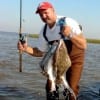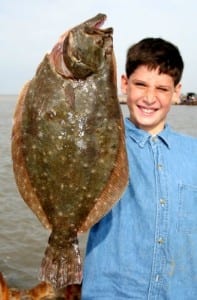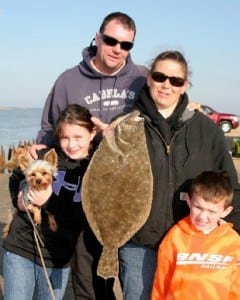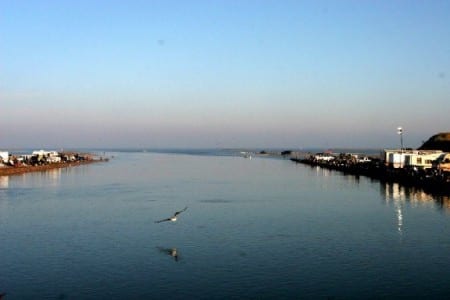 By Ed Snyder/Outdoors
By Ed Snyder/Outdoors
Rollover Pass, Gilchrist on Bolivar, TX.
In a futile effort to keep their bending fishing poles hidden from the eyes of others, the anglers attempt to hide their wriggling catches out of sight in hopes of keeping the flounder run quiet, however, were soon undone as anglers quickly spotted those wriggling flatfish…whispering….”Pssst, the flounder are running!!!”
As the air temps become more comfortable with cooling weather dropping water temps in the bays and flats by just a few degrees at first, stirring the biological drive of the male flounder, starting them on their journey to the Gulf before colder fronts arrived. And soon when the chilling effect of Autumns cold fronts begin plummeting the air and water temps into the low 60s almost overnight, the larger female flounder begin a STAMPEDE of sorts from the bays to the Gulf, hurriedly following the males out to their berthing beds!
This massive migration of flounder occurs every Autumn when flounder swim the gauntlet of fishermen who’re anxiously awaiting the flounder to leave the bays, passes, and cuts to reach their ancestral spawning grounds in the Gulf Mexico. This annual Fall run of millions of flounder ensures that enough will get through the maze of fishing lines that await them to enable the species to reproduce.
Spawning occurs in 100ft depths, with the flounder hatchlings eyes separated at first, looking much like normal fish, begin their massive homecoming to the warming spring bays. There, they transform with eyes rotating to one side, developing into flounder like features as we know them. After only one year of ravenously feeding in the shallow bays and sloughs these new born flounder can grow from 8 to 10inches. Then in their 2nd year of life will grow from 12- to- 15inches. Flounder that grow above 12inches become females while those holding at, or below 12inches remain males.
Legal catches in Texas are 14inches minimum with a 5 fish creel from January to October. Then, as a conservational effort by Texas Parks & Wildlife, the month of November resets limits for a 14inch with only a two fish a day creel limit. But after November ends the regular limit of five fish re-apply. All anglers must comply with Texas rules and regulations with a state fishing license and a saltwater stamp. Failure to do so can result in stiff fines, loss of fishing tackle, loss of vehicle, or all three.
 Rollover Pass, -alias- Fish pass, or Flounder pass, is probably one of Galveston Bays most famous saltwater fishing sites, drawing an estimated 80,000 visiting anglers who fish these tidal waters each year.
Rollover Pass, -alias- Fish pass, or Flounder pass, is probably one of Galveston Bays most famous saltwater fishing sites, drawing an estimated 80,000 visiting anglers who fish these tidal waters each year.
Rollover, best known for its fishing conveniences, where anglers can bumper-up next to the action, enjoy “ruffing-it” with creature comforts of air conditioning, televisions, and frigidaired beverages. Motor-homes, camper trailers, and cab-over pick-em-ups line up side by side with makeshift tents maneuver for fishing spots.
Rollover Pass, well known for being user-friendly, makes it possible for physically impaired anglers wheelchair access the fishing areas to enjoy the enjoyable. There are also several RV Parks in the Rollover area who cater to campers and motor homes.
Located on Bolivar Peninsula’s scenic highway 87, betwixt the coastal resort towns of High Island and Crystal Beach, the 50 foot wide by 1,700 foot long Pass cuts through the small, but active, fishing village of Gilchrist. Rollover Pass, reconstructed in 1956 to improve fishing conditions in the upper Galveston Bay system, the Pass allows incoming Gulf tides to breath new life into the bay system each day, with its outgoing bayside tides meeting incoming Gulf tides to help flush out the bay system. This constant tidal action has created a unique outdoor recreational opportunity for 1000’s of anglers, as its tidal movements attract popular inshore fish species such as Speckled Trout, Redfish, flounder, Sheepshead, Black Drum, and Golden Croaker.
The importance of this fishing area to the State of Texas, as well as to the 1,000’s of fishing families who visit each year, can be re-viewed each time that you visit Rollover. Visitors from all walks of life arrive from “everywhere” to fish among vehicles sporting license plates from as far away as Oregon, Minnesota, and Canada can be seen nestled amongst the more local tags of Texas, Oklahoma, and Louisiana.
Of all the species to fish for the Flounder is probably the #1 fish attraction for the anglers who target Rollover each year during the major flounder runs of spring and Fall. An estimated over 30,000 fishing public visit here each year during those flounder runs. The importance of this shows up in the tills of the local businesses during these annual fishing phenomenon’s.
 Although the Pass is privately owned, Rollover is maintained by the GCA (Gilchrist Community Assn) for everyone to enjoy as a free entry park. Presently, the Pass is under threat of being closed to the public by the GLO (General Land Office). The Gilchrist Community Assn came together to take over the legal battles for this “very important” fishing facility to keep it open to the public! But to be able to do this, GCA President Ted Vega petitions, “we need support of the public by keeping up with their trash around their fishing areas to help keep the area clean and neat for other families to enjoy.”
Although the Pass is privately owned, Rollover is maintained by the GCA (Gilchrist Community Assn) for everyone to enjoy as a free entry park. Presently, the Pass is under threat of being closed to the public by the GLO (General Land Office). The Gilchrist Community Assn came together to take over the legal battles for this “very important” fishing facility to keep it open to the public! But to be able to do this, GCA President Ted Vega petitions, “we need support of the public by keeping up with their trash around their fishing areas to help keep the area clean and neat for other families to enjoy.”
“We also hold several fund raisers throughout the year”, Ted Vega (GCA President) informs, stating the GCA also welcomes financial support from the public, by either joining as a supporting member, or through personal donations which are collected from the GCA jars placed throughout the Gilchrist and Bolivar Peninsula business community. “This helps us maintain the Pass as well cover the expense of our legal endeavors for keeping the pass open for the public.
“It’s bottom rigging here folks, as Flounder are mostly bottom feeders which require terminal tackle with 1 oz to 3 oz No-roll or barrel type sinkers, Carolina rigged with or, 2/0 circle or #8 treble -hooks tied to a 2 ft leader. Best baits are live finger mullet, mud-minnows hooked through the nose or below the dorsal fin. The main tech is to cast out about 15 to 20 yards past the bulkhead then letting the bait settle, slowly move in about 2ft drags until you feel the flounder pickup the bait. This is when it gets tricky. The flounder usually grabs the minnow about half way down, then will try to swallow it. After swallowing, the flounder will then start moving off. THIS is when you set the hook! Or, if you’re using a Berkley Gulp set the hook as soon as you feel the flounder strike.
Artificial anglers use bottom bumping jigs with soft plastics or spoons definitely catch their share of flounder, with the new Berkley Gulp baits being among the best choice for artificial anglers. Another good choice is the “Cajun-rig” which requires using 2inch long strips from the white belly of a flounder impaled on jigs which are then bounced or -massaged- along the bottom to attract the flounder bite. My personal choice for flounder however are the Berkley Gulp soft plastic lures, which are soft plastics impregnated with an attraction/reaction type scent. The Gulps really do work the best for me though.
Although October through November are peak flounder periods for anglers fishing the pass, December and January can also be prime flounder fishing times (weather permitting) when the larger flounder move through the cut. There are three classifications of flounder. Keepers -(14 to 20inches)- Door Mats -(20 to 24inches)- and Saddle Blankets -(24 to 30inches)- But there have been a few flatfish caught over 30inches, which we refer to as Mega-Flounder. My best catch at Rollover was a 28inch/8lb saddle blanket caught back in the early ‘80s. This was a late November catch on a mud minnow.
 Flounder, for the most part, are finicky feeders, with most anglers giving them time to swallow the bait prior to hook-setting, but experienced flounder anglers develop a sixth sense and can feel Flounder hit the bait- roll the bait- and swallow the bait before moving off where they then set the hook. Being of the flatfish family, the Flounder, having both eyes on the color side of its body, is unique in itself providing four filets per fish, two from the color side and two from the white side.
Flounder, for the most part, are finicky feeders, with most anglers giving them time to swallow the bait prior to hook-setting, but experienced flounder anglers develop a sixth sense and can feel Flounder hit the bait- roll the bait- and swallow the bait before moving off where they then set the hook. Being of the flatfish family, the Flounder, having both eyes on the color side of its body, is unique in itself providing four filets per fish, two from the color side and two from the white side.
Flounder are normally are grilled or baked whole with crab and shrimp stuffing- or- my favorite, stuffing with Cajun style Boudin – Yum-Yum! While others fillet into strips, dip in tempura or Cajun fish fry seasoning, then deep-fried to crispy purr-fection and served with seasoned French fries and your favorite chilled beverage … …”Oh My”
For Daily Fishing Updates Call Miss Nancy’s Bait Camp at 484-560-9323 – or click Face Book/Miss Nancy’s Bait Camp –
This article sponsored by Miss Nancy’s Bait Camp , Sting-A-Ree Marina and Bait Camp,The Beach Triton and Crystal Beach Local News.com

 Posted in
Posted in 

























